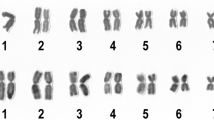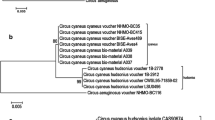Abstract
The hamlets are a group of vividly colored fish species of the Serranidae family differentiated only by the color pattern of the body. Although there are divergent views about hamlet taxonomy, experimental and field observations have shown a strong assortative mating, justifying a species status for the different color morphs. Here we analyze the level of evolutionary divergence among six species in respect of mitochondrial DNA, with a view to contrasting the pattern observed with color partitions and previous results obtained with isozymes. The estimated molecular distance among species was low and of the same magnitude as nucleotide diversity within species. Consequently, the net distance and hence the time of divergence between taxa was virtually zero in most comparisons. Although not critically tested, haplotype distribution showed no clear phylogeographic structure, and in many cases the most closely related haplotypes were found at different geographical locations. The absence of differentiated clades between species, based on mitochondrial DNA and isozyme analysis, may have one of two possible origins: a very recent differentiation of species or a lack of absolute barriers to gene flow. However, the available information is insufficient to determine the effect of one or the other, and may require supplementary information from other genes as well as experiments on hybrid fertility. Finally, based on some biological evidence, we suggest that self-fertilization may be an interesting phenomenon to be tested in Hypoplectrus.

Similar content being viewed by others
References
Acero A, Garzón J (1994) Descripción de una nueva especie de Hypoplectrus (Pisces: Serranidae) del Caribe occidental y comentarios sobre las especies colombianas del género. An Inst Invest Mar Punta Betín 23:4–14
Albertson RC, Markert JA, Danley PD, Kocher TD (1999) Phylogeny of a rapidly evolving clade: the cichlid fishes of Lake Malawi, East Africa. Proc Natl Acad Sci USA 96:5107–5110
Beebe W, Tee-Van J (1933) Field book of the shore fishes of Bermuda. Putnam, New York , pp 134–135
Breder ChM (1929) Field book of marine fishes of the Atlantic coast from Labrador to Texas. Putnam, New York , pp 164–165
Clark E (1959) Functional hermaphroditism and self-fertilization in serranid fish. Science 129:215–216
Clement M, Posada D, Crandall KA (2000) TCR: a computer program to estimate gene genealogies. Mol Ecol 9:1657–1660
Cole KS, Noakes DLG (1997) Gonadal development and sexual allocation in mangrove killifish Rivulus marmoratus (Pisces, Atherinomorpha) Copeia 1997:596–600
Doi M, Matsuda M, Tomaru M, Matsubayashi H, Oguma Y (2001) A locus for female discrimination behavior causing sexual isolation in Drosophila. Proc Natl Acad Sci USA 98:6714–6719
Domeier ML (1994) Speciation in the serranid fish Hypoplectrus. Bull Mar Sci 54:103–141
Graves JE, Rosenblatt RH (1980) Genetic relationships of the color morphs of the serranid fish Hypoplectrus unicolor. Evolution 34:240–245
Guitart D (1977) Sinopsis de los peces marinos de Cuba, vol III. Acad Cienc Cuba
Humman P (1994) Reef fish identification, 2nd edn. New World Publications, Jacksonville, Fla., pp 111–125
Jordan DS, Everman BW (1896) The fishes of north and middle America, vol 1. Smithsonian Institution, United States National Museum, Washington, D.C., pp 1189–1194
Kimura M (1980) A simple method for estimating evolutionary rate of base substitution through comparative studies of nucleotide sequences. J Mol Evol 16:111–120
Kocher TD, Thomas WK, Meyer A, Edwards SV, Pääbo S, Villablanca FX, Wilson AC (1989) Dynamics of mitochondrial DNA evolution in animals: amplification and sequencing with conserved primers. Proc Natl Acad Sci USA 86:6196–6200
Kumar S, Tamura K, Jakobsen IB, Nei M (2001) MEGA2: molecular evolutionary genetics analysis software. Bioinformatics 17:1244–1245
Mallet J, Joron M (1999) Evolution of diversity in warning color and mimicry: polymorphisms, shifting balance, and speciation. Annu Rev Ecol Syst 30:201–233
McMillan WO, Palumbi SR (1997) Rapid rate of control-region evolution in Pacific butterflyfishes (Chaetodontidae). J Mol Evol 45:473–84
McMillan WO, Weight LA, Palumbi SR (1999) Color pattern evolution, assortative mating, and genetic differentiation in brightly colored butterflyfishes (Chaetodontidae). Evolution 53:247–260
Meyer A, Kocher TD, Basasibwaki P, Wilson AC (1990) Monophyletic origin of Lake Victoria cichlid fishes suggested by mitochondrial DNA sequences. Nature 347:550–553
Moran P, Kornfield I (1993) Retention of ancestral polymorphism in the Mbuna species flock (Teleostei: Cichlidae) of Lake Malawi. Mol Biol Evol 10:1015–1029
Nei M (1987) Molecular evolutionary genetics. Columbia University Press, New York
Nei M, Kumar S (2000) Molecular evolution and phylogenetics. Oxford University Press, New York
Palumbi SR, Martin AP, Romano S, McMillan WO, Stice L, Grabowsqui G (1991) The simple fool's guide to PCR. ver. 2.0. University of Hawaii, Honolulu, HI
Parker A, Kornfield I (1997) Evolution of the mitochondrial DNA control region in the mbuna (Cichlidae) species flock of the Lake Malawi, East Africa. J Mol Evol 45:70–83
Poey F (2000) Ictiología cubana, vol I. Imagen contemporánea, Colección Biblioteca de Clásicos Cubanos, No. 7
Posada D., Crandall KA, Templeton AR (2000) GEODIS: a program for the cladistic nested analysis of the geographical distribution of genetic haplotypes. Mol Ecol 9:487–488
Randall JE (1967) Food habits of the reef fishes of the West Indies. Stud Trop Oceanogr 5:665–847
Randall JE (1968) Caribbean reef fishes. Trop Fish Hobbyist, N.J.
Rocha-Olivares A, Kimbrell CA, Eitner BJ, Vetter RD (1999) Evolution of a mitochondrial cytochrome b gene sequence in the species-rich genus Sebastes (Teleostei, Scorpaenidae) and its utility in testing the monophyly of the subgenus Sebastomus. Mol Phylogenet Evol 11:426–440
Rosenthal E, Coutelle O, Craxton M (1993) Large-scale production of DNA sequencing templates by microtitre format PCR. Nucleic Acids Res 21:173–174
Schneider S, Roessli D, Excoffier L (2000) Arlequin ver 2.000: a software for population genetics data analysis. Genetics and Biometry Laboratory, University of Geneva, Switzerland
Soto CG, Leatherland JF, Noakes DLG (1992) Gonadal histology in the self-fertilizing hermaphroditic fish Rivulus marmoratus Pisces Cyprinodontidae. Can J Zool 70:2338–2347
Takahata N, Slatkin M (1984) Mitochondrial gene flow. Proc Natl Acad Sci USA 81:1764–1767
Templeton AR, Crandall KA, Sing CF (1992) A cladistic analysis of phenotypic associations with haplotypes inferred from restriction endonuclease mapping and DNA sequence data. III. Cladogram estimation. Genetics 132:619–633
Templeton AR, Routman E, Phillips CA (1995) Separating population structure from population history: a cladistic analysis of the geographical distribution of mitochondrial DNA haplotypes in the tiger salamander, Amblystoma tigrinum. Genetics 140:767–782
Thompson JD, Gibson TJ, Plewniak F, Jeanmougin F, Higgins DG (1997) The ClustalX windows interface: flexible strategies for multiple sequence alignment aided by quality analysis tools. Nucleic Acids Res 24:4876–4882
Thresher R (1978) Polymorphism, mimicry and evolution of the hamlets (Hypoplectrus, Serranidae). Bull Mar Sci 28:345–353
Via S (2001) Sympatric speciation in animals: the ugly duckling grows up. Trends Ecol Evol 16:381–390
Acknowledgements
We thank Gaspar González, Georgina Espinosa and Beatriz Guitart for valuable comments and suggestions throughout this study; Dominique Vautrin for laboratory assistance, and anonymous reviewers for helpful comments. We state that the experiments carried out during this investigation comply with the current laws of Cuba.
Author information
Authors and Affiliations
Corresponding author
Additional information
Communicated by S.A. Poulet, Roscoff
Rights and permissions
About this article
Cite this article
García-Machado, E., Chevalier Monteagudo, P.P. & Solignac, M. Lack of mtDNA differentiation among hamlets (Hypoplectrus, Serranidae). Marine Biology 144, 147–152 (2004). https://doi.org/10.1007/s00227-003-1174-9
Received:
Accepted:
Published:
Issue Date:
DOI: https://doi.org/10.1007/s00227-003-1174-9




